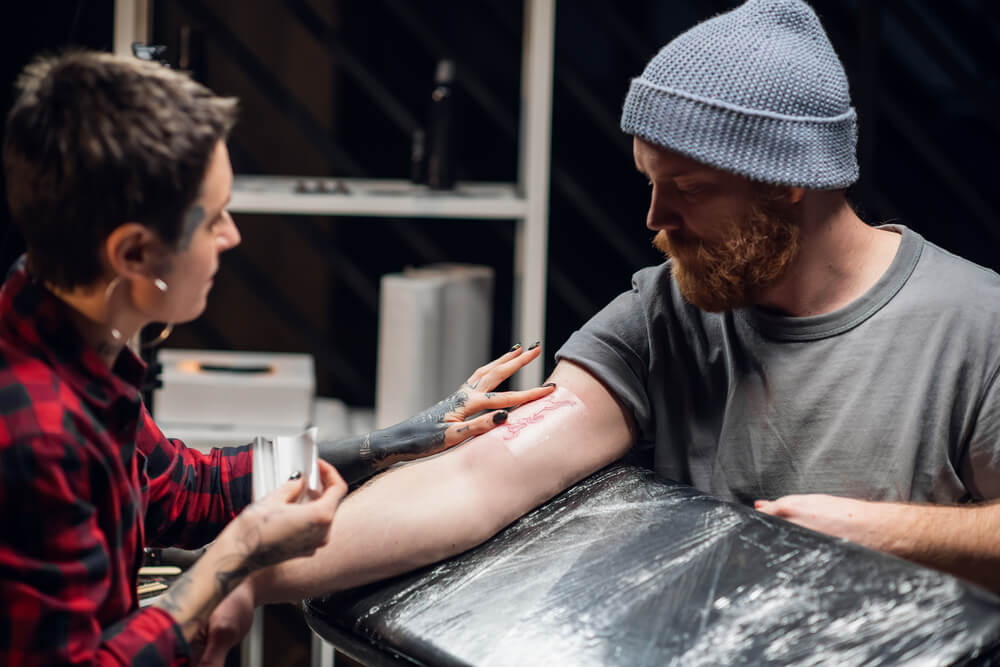If you’re like most people )well, most people I know), you probably have a lot of questions about Saniderm – how it works, how long to leave it on, and whether it’s right for you. In this post, we’ll answer all your questions about Saniderm, so that you can make an informed decision about whether or not it’s the right tattoo aftercare product for you.
What is Saniderm?
Saniderm is a patented, FDA-approved product that is used to cover tattoos and protect them from infection. It is made of a thin, flexible material that allows the skin to breathe while still protecting the tattoo from outside contaminants.
What are its benefits for tattoos?
Saniderm has many benefits for tattoos, including:
1. It protects the tattoo from infection by creating a barrier between the tattoo and outside contaminants.
2. It helps the tattoo heal faster by keeping it moist and allowing the skin to breathe.
3. It prevents scabbing and scarring by allowing the tattoo to heal without being exposed to the air.
4. It makes the tattoo less itchy and painful by protecting it from friction and irritation.
5. It keeps the tattoo looking bright and vibrant by filtering out sunlight and other UV rays.
How long should you leave Saniderm on a tattoo before removing it?
Saniderm should be left on the tattoo for at least 24 hours, but no longer than 72 hours. If you remove it before 24 hours, the tattoo will not have had enough time to heal and may become infected. If you leave it on for longer than 72 hours, the adhesive may begin to irritate the skin and cause the tattoo to peel.
How do you remove Saniderm?
Saniderm can be removed by gently peeling it off the skin. If the adhesive is still attached to the skin, you can use a cotton ball soaked in rubbing alcohol to help loosen it. Once the adhesive is removed, you should wash the tattoo with soap and water to remove any residue.
Is Saniderm right for you?
Saniderm is a great option for people who want to protect their tattoos from infection and speed up the healing process. It is also ideal for people who have sensitive skin or allergies to other aftercare products. However, it is not recommended for people who have very oily skin, as it may cause the tattoo to peel.
If you have any other questions about Saniderm or tattoo aftercare in general, feel free to contact us or visit our website.
What are the risks associated with leaving Saniderm on too long?
The risks associated with leaving Saniderm on for too long include the adhesive beginning to irritate the skin and causing the tattoo to peel, the tattoo not healing properly, and ultimately becoming infected. If you experience any of these problems, discontinue the use of Saniderm and contact your doctor.
If you’re still unsure about whether Saniderm is right for you, consult with a doctor or tattoo artist. They can help you decide which aftercare product is best for your individual
The tattoo may fade if it is exposed to UV rays for too long, and it may become wrinkled if it is not allowed to dry properly.
Are there risks associated with leaving Saniderm on for not enough time?
The risks associated with leaving Saniderm on for not enough time could be that the tattoo may become infected if it is not protected from outside contaminants, the tattoo may not heal properly and may become scabbed or scarred, and the ink may fade.
How can you tell if your Saniderm is still effective?
You can tell if your Saniderm is still effective if it is still firmly adhered to the skin and is not causing any irritation. If you have any concerns, discontinue the use of the product, and consult with your doctor.
Saniderm should be applied to clean, dry skin. The tattoo should be free of any ointment, lotion, or other aftercare products.
To apply Saniderm, remove the clear backing and apply the adhesive side to the tattoo. Gently smooth out any bubbles or wrinkles. Once the Saniderm is in place, cover it with a bandage or piece of cloth to keep it from moving.
How do you replace Saniderm if necessary?
If Saniderm becomes dislodged or falls off, replace it with a new piece and secure it in place with a bandage or cloth. If the adhesive begins to wear off, replace it with a new piece. Do not reuse old pieces of Saniderm.
Where can I purchase Saniderm products if I want to try them for myself?
Saniderm products are available at most tattoo shops and many online retailers. You can also purchase it from the Saniderm website. If you have any questions, feel free to contact us or visit our website.
Where to store Saniderm
Saniderm should be stored in a cool, dry place out of direct sunlight. The adhesive side should be facing up to avoid damaging the product.
Other ways to help speed up your tattoo’s healing process
In addition to using Saniderm, there are a few other things you can do to help speed up your tattoo’s healing process.
More Tattoo Aftercare
1. Keep the tattoo clean and dry: Gently wash the tattoo with antimicrobial soap and water up to three times a day.
2. Avoid contact with other people’s tattoos: This can expose your tattoo to bacteria and increase the risk of infection.
3. Do not pick or scratch at the tattoo: This can damage the tattoo and delay the healing process.
4. Follow your tattoo artist’s aftercare instructions: They know best how to care for your tattoo.
To Recap
When using Saniderm, it is important to follow the instructions carefully. Leaving Saniderm on for too long or not long enough can cause problems with the healing process and may lead to infection. It is also important to replace Saniderm if it becomes dislodged or falls off. Saniderm can be purchased at most tattoo shops and online retailers.
When you get a tattoo, you want to take as much care of it as possible and that includes using the right aftercare. These tips and tricks will help you get the most out of your tattoo aftercare and keep your tattoo looking great for years to come!



